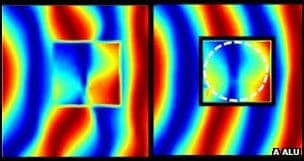The much dreamed off invisibility cloak is just a few tiny steps away, after remarkable research in the field, many backed by military interests, have sparked some amazing advances. In the last few years alone, scientists have managed to successfully cloak various objects either using meta-materials that bent light around an object to conceal it or electrically stimulated nanotubes which cause the human eye to perceive a mirage-like effect and thus conceal the object. Just a few weeks ago, scientists manage to hide an event in time after they developed a time cloak.

However, we’re still in a highly incipient state as far as a full-on invisibility cloak in its all rightful manner is concerned. You see, these devices are only capable of rending a particular object only in 2D, from a particular angle, which although doesn’t seem particularly useful, it’s still been a remarkable progress. Now, in a recently published paper, University of Texas scientists describe how they’ve been able to use plasmonic meta-materials to make an 18-inch cylindrical tube invisible – a full 3-D cloak.
What we actually perceive with our eyes is actually information transmitted by light which bounces off objects in our surroundings, as its constituent atoms absorb, transmit or reflect electric and magnetic fields. One might say that the world around us, as we visually see it, is not the real one, but its reflection. Bearing in mind this, if one can manipulate or stop light from bouncing off an object altogether, than that object would become invisible.
” That means the object is invisible, from any angle of observation.
“This object’s invisibility is independent of where the observer is,” Professor Andrea Alu, the study’s co-author, tells Danger Room. “So you’d walk right around it, and never see it.”
Plasmonic materials can be designed to have effects on the fields that are precisely opposed to those of the object, and thus cancel out the light scattering from an object. When the plasmonic shell was coated on a cylinder, the two cancelled each other out, and became invisible in the high-frequency wavelengths, like the microwave spectrum – it remained perceivable as always in the visual wavelength spectrum, however.
The plasmonic material shell is, in essence, a photo-negative of the object being cloaked, so for this to work the shell needs to be tailored specifically for the object to be cloaked. Cloaking in visible light, hiding more complex shapes and materials, is still extremely distant, however these recent advances, with this latest one to bolster as well, proves that it’s far from being impossible.
“We have some ideas to make it work,” Alu says. “But the human eye is not our priority. Right now, we’re focused on improving biomedical imaging.”
The study was presented in a recent edition of the New Journal of Physics.






